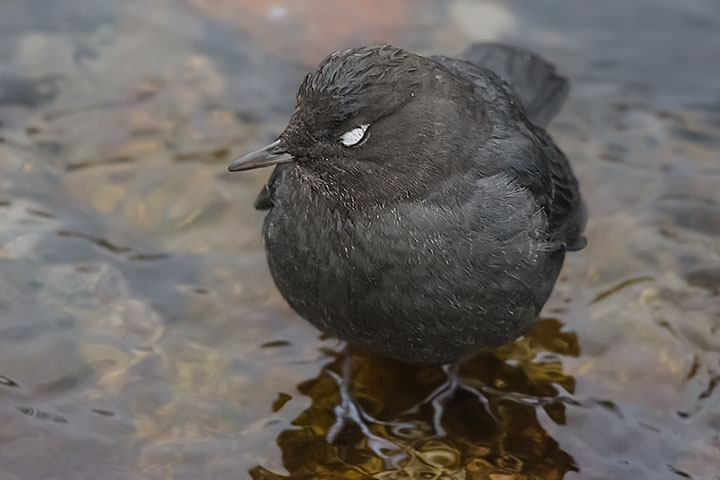I learned something from the CBC (Canadian Broadcasting Corporation) this morning. Frank Ritcey of Kamloops was interviewed on the subject of why dippers dip. Alas, the short answer to that question was: We don’t know.
However, Mr. Ritcey also pointed out that dippers have a white eyelid. Wow, while I had seen this many times when dipper watching, I had thought that I was seeing the bird’s nictitating membrane. I was wrong. I promptly went to my favourite spot for observing dippers and waited for a blink. My dippers did not disappoint.
An American Dipper blinks and reveals its white eyelid. The eyelid is apparently covered with exceedingly small white feathers, some hint of which is apparent even at this resolution.

While I watched dippers hunt, one brought a clutch of kokanee eggs to the surface, and then, obligingly, blinked.

The dipper expedition was worth it for not only the shots of the blink, but this one of a dipper coming in for a landing on (what is clearly) a favourite perch in the stream.


Thanks for yet another great bit of enlightenment. I too thought it was the nictitating membrane we were seeing.
Ditto!
Frank Ritcey is an expert on so many levels: he is an accomplished guide, photographer, caregiver of our lands, local expert on snakes, beavers, bears, and ungulates, plants, birds (though he doesn’t profess to be an expert on those, he refers to Rick Howie our local expert as being an expert on birds). He leads groups on snake walks here in Kamloops (6 local species) and he is a great speaker, family man, and nature lover. Always a pleasure to hear him being interviewed on the media, and nice to hear he shared the dipper eyelid fact for you and your followers.
Sue, thank you for this. I have known of Frank for years. Alas, we live in disparate valleys and haven’t met. This is also somewhat true of Rick Howie; I have known him a long time, but we have yet to meet face to face.
I heard the piece with Ritcey and had to go amend info in my scribbler on nature, having thought, as well, the white lid the nictitating membrane. Charming shot of the dipper landing.
I have long admired your work Alistair and I periodically make it into the Kootenays to ‘poach’ some video of your local wildlife. We will have to catch up at some point and go out on a shoot. I shudder when folks introduce me as an expert of anything other than perhaps flippancy or general tom-foolery 🙂 I am however an enthusiastic observer of all things in the natural world and ask way more questions than I answer. My father, Ralph Ritcey is a biologist and can be described as a true expert in many fields and he considers your site one of the best. If you ever make it out to Kamloops I am sure there would be a couple of Ritcey’s around that would be happy to give you a guided tour to the local hotspots.
Frank, that you know of me is a bit scary, for I generally prefer to know rather than to be known. And like you, I am skittish about being considered knowledgeable about anything (although, I could proclaim endlessly on the subject of rainbows). More to the point, I would welcome the opportunity to wander the wilds with you (and your father), either in your valley or mine.
I have been birding for over 40+ years & didn’t know this. It just goes to show there is always something new in the birding field and it is another example of why birding is such a fascination hobby/avocation.
Do they know why they have a white eyelid. How is the white eyelid different from the nictitating membrane besides being white?
Lindell, ah that is problematic. However, I note that there is a precedent: the white sclera of the human eye. This is unusual among primates. Why do we have (what is know as) the white of the eye when most apes do not? The suspicion is that it is to make eye signals easy between humans. Could this also be the case with dippers? And as to the nictitating membrane, all birds have them, and even humans have a residual version.
http://www.sibleyguides.com/2013/04/the-white-eyelid-of-american-dipper/
Thank you, Alistair!
I was so pleased to be sitting near you at Touchstones Museum – I am full of admiration!
you are a constant source of interesting info. as well as amazing pictures. many thanks. Irene mcI
First, wonderful photos! Dippers aren’t easy to photograph but you’re captured them beautifully.
Second, I’m pretty sure that the food item in this post as well as your “Picky dippers” post is a tube-case caddisfly larva rather than kokanee eggs. What look like individual eggs are actually tiny pieces of gravel, cemented together into a case. Case-building caddis aren’t dippers’ preferred insect food (that honor goes to mayflies) but at this time of year they’re more abundant than mayflies. Dippers have to break the case apart to get to the larva inside — which may explain the behavior you saw (and, again, photographed beautifully) in your other post. (Sorry to geek out, but dipper ecology was my dissertation topic and I saw this behavior many times.)
Katherine, thank you for this. I have long wanted to be able to interact with a real scientist who has done work on dippers. I welcome the insight you offered about the caddisfly larvae. That would explain a good deal of what I see (although not all of it). In the hope of further insights from you, I will also respond to your personal email address.